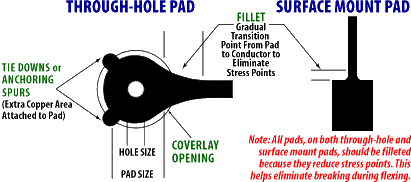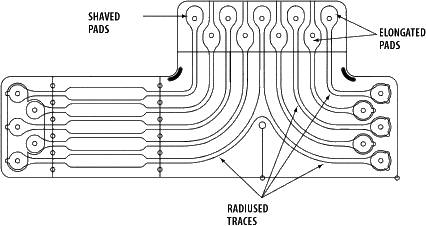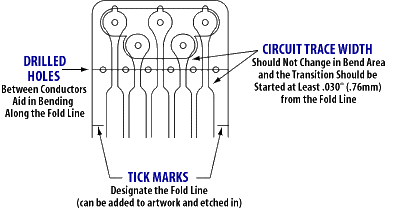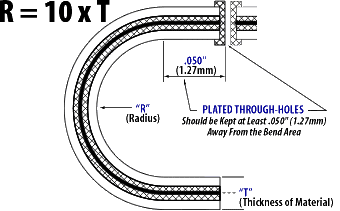This section of our guide addresses rules specifically pertaining to conductor and pad design recommendations. Due to the flexible nature of the material during both manufacturing and application use, the following information is recommended to produce the highest yielding and best functioning flexible circuit.
Conductor Pad Design:
Pads should have tie downs (also called anchoring spurs or rabbit ears). Tie-downs are captured by the coverlay to anchor the copper to prevent separation between the copper and the base material.
Filleting:
All pads, on both through-hole and surface mount pads, should be filleted because they reduce stress points. This helps eliminate breaking during flexing.

Calculating Pad Size:
Recommended pad size is dependent on the component pad requirement that is specific to your application.
FORMULA:
Hole size + customer required tolerances + .020″ (.50mm)
EXAMPLE:
Hole size (finished): .030″ (.76mm)
Customer tolerance: ±.003″ (.07mm)
All Flex manufactured factor: .020″ (.5mm)
Calculated pad size required is: .053″ (1.34mm)

Radiused traces help to alleviate breaking during folding and bending (refer to diagram above for example).
I-Beam vs. Staggered Conductors:
I-Beam constructions occur where the conductors on both layers lie directly on top of each other, increases the stiffness of the circuit through fold areas. A better alternative is to stagger conductors, alternating their location to retain the maximum flexibility of the circuit (see below).

Fold Lines may be designated by drilled holes or “tick” marks. These features aid in bending and designating bend locations.
Circuit trace should not change in bend areas and the transition should be at least .030″ (.76mm) from the fold line.

Bend Radius of a flex should be approximately 10 times the material thickness and at least .050″ away from a plated through hole.
Button plating is a process that allows for the through holes to maintain their connection while the traces are not plated, allowing the circuit to have increased flexibility.
